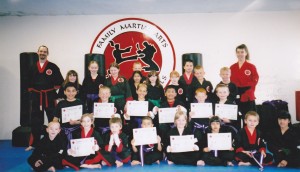Kids Taekwondo – Getting Fun and Enjoyment in Your Classes
From personal experience, one of the key reasons any student will continue to do the activity of martial arts is because they enjoy it and have fun, particularly children. The key is to get a balance of fun and skill learning in your classes and to understand that as the child develops and progresses through their martial arts training, their concept of fun and enjoyment may also change with their development.
Defining Fun and Enjoyment: Surprisingly fun and enjoyment is different for everybody and is also quite complex.
 Many researchers within the physical education field have tried to define it. In most research enjoyment has been defined as ‘A positive affective response to physical activity reflecting feelings and perceptions such as pleasure, liking and fun’, (De Bourdeaudhuij’ 1998)
Many researchers within the physical education field have tried to define it. In most research enjoyment has been defined as ‘A positive affective response to physical activity reflecting feelings and perceptions such as pleasure, liking and fun’, (De Bourdeaudhuij’ 1998)
Others have examined the constituents of fun in youth sport participants and it was found that extrinsic factors such as ‘excitement in sport’, ‘personal accomplishment’, and ‘doing the skills’ were more important to enjoyment compared to extrinsic factors like ‘winning rewards’ and ‘pleasing others’.
Fun and the Beginner’s Curriculum: Many of these descriptions of fun emphasise skill development, but other studies have found that children stopped enjoying themselves when too much time was spent on skill development. In other words, when teaching martial arts to children, if you spend most of your time focussed on perfecting skill, the child is likely to get bored, lose a sense of fun and enjoyment and drop out.
There are two considerations the martial arts instructor should take into account; first of all, of those who join your school, how many of them are top athletes? Statistically you may find that it is only a small proportion. Second of all, out of the four years it may take to get a black belt, how critical is it for the beginners (first year of training) to perfect a large number of techniques and skills? Perhaps, learning a few simple techniques may be more beneficial rather than demanding the memory of 3 – 4 kata/patterns, set step sparring etc. with many complex moves, which for a large number of children can lead to anxiety, stress and therefore drop-out.
Yet many instructors are tempted to continue to gear their classes and curriculum to top athletes and the talented. An interesting study carried out in the physical education field by Janet Portman indicated that low-skilled children in a PE class perceived ‘fun’ as ‘success’ (O’Reilly et al. 2001). Thus if activities were easy to perform, then the children were having fun. If the children were unable to perform the activity, then, the ‘lack of success was equated as a lack of fun’ (p.212). This theory should make instructors reconsider their children’s beginner’s curriculum. Is it so difficult that the children fail to feel progress and success and drop out of training? The idea is not to drop standards necessarily, but perhaps to simplify the beginner’s curriculum, have less of it to learn in the first year of training. Once the child has a level of competence then they are in a position to expand on the curriculum and the level of skill required in the second year of training. Thus training will be considered enjoyable rather than a burden.
Friends and Family: Other researchers believe that in essence, fun relied on social interaction such as being with friends and family, making new friends. Thus getting the friends and family involved is important and this could be a key way to recruit new students. Instructors should allow children to partner or team with their friends for maximum enjoyment providing it does not disrupt the class.
Competition: beware of over-emphasizing competition. This potentially is a problem and key cause of ‘drop-out’. The key is to put more importance into other elements of competition such as co-operation among team mates, celebration of personal achievement, as opposed to winning and losing in order for it to be fun. Thus ‘a pinch of competition’ could accentuate fun. Instructors could incorporate small competitive team games in their teaching as part of the class, but avoid dwelling on performance and results.
Exertion: Another interesting factor that could affect fun and enjoyment is the role of exertion or even the perception of exertion of a particular activity. From personal experience, in my past training, the belief was that one was unable to achieve success in martial arts without going through a certain level of pain. This probably applied to children as well. It was no wonder that the drop out rate in martial arts clubs 10-15 years ago was phenomenal. Research has indicated that children prefer activities with lower levels of exertion, and drop-out rates are higher if training is very intense. Children like vigorous activity providing it is sporadic, thus the key is to teach activities in bursts and allow rests in between. In this way the children do not perceive the activity as painful. So remember, the next time you hear children groan in class because you over demand press-ups or they have a twisted look on their faces because the drill goes on forever, the chances are you will lose students.
Key tips for the childrens’ instructor
- Overall, I believe that for the majority of children, it is best to adopt Janet Portman’s strategies for low-skilled children, that is, children will experience fun in classes if physical activity is uncomplicated (simple curriculum for children), low-organised, has few rules, requires minimum skills and thus has the highest chances of success for all, particularly for beginners.
- Once a certain level of experience in training has been achieved then it is feasible to place more emphasis on skill progression as at this stage the child may gain a level of extrinsic enjoyment form being able to carry out the activity at a certain level of skill.
- Competition should be de-emphasised and participation by all should be encouraged, for example at events like demonstrations regardless of skill level.
- Competitive games are fine providing score keeping is ignored and emphasis is placed on developing positive attitudes and striving for personal improvement rather than winning or losing.
- Try to keep friends together to ensure maximum enjoyment in the activity.
- Avoid treating children like ‘Miniature adults’(Corbin 2002) and avoid teaching adults and children together.
- It is very important to get the balance of exertion right and this process continues as the student progresses through the ranks. Typically, if students, children or adults find that the classes are painful and fail to give a sense of well-being, then the chances are the student will drop out of training.
Catarina Murphy has practised martial arts since 1988. A 3rd Degree Black Belt and a Master’s Degree at Loughborough University in Physical Education, she now practices and teaches Kaizendo Fitness.
References:
De Bourdeaudhuij, I (1998). Behavioural factors associated with Physical activity in young people (pp98-118). Health Education Authority (Ed.) Young & Active? Young People and health enhancing physical activity – evidence and implications. London: Health education authority.
O’Reilly E. et al (2001). They ought to enjoy Physical Activity, You Know? Struggling with fun in Physical education. Sport, Education and Society, Vol.6, No.2, pp.211-221.
Corbin, C.B. (2002) Physical Activity for Everyone: What Every Physical Educator Should Know about Promoting Life Long Physical activity. Journal of Teaching Physical Education, 21, pp.128-144. Human Kinetics Publishers, INC.




